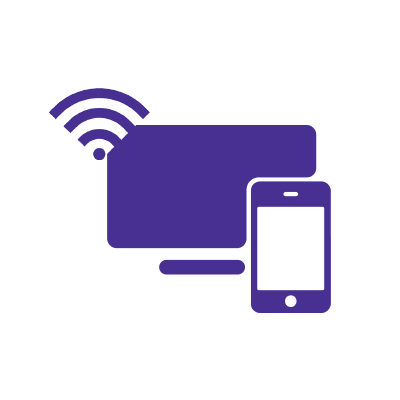Social media impersonation:
How to identify, prevent and respond
Social media impersonation is a growing concern in the digital world. Losses to fraud initiated on social media platforms totaled $1.2 billion in 2022.
This article will provide an in-depth analysis of social media impersonation, its consequences, and the best practices for prevention and response.
- What is social media impersonation?
- Types of impersonation attacks
- Techniques used by impersonators
- Examples of social media impersonation schemes
- Detecting impersonation schemes
- Best practices for prevention: Tips and video
- What are social media sites doing about it?
- Responding to social media impersonation
- Frequently asked questions
- Looking for related topics?
- Build the perfect plan to meet your security needs

eero Plus
eero Plus protects your family online with a password manager to safely create, store and share passwords, virus and malware protection and a VPN that lets you browse the web safely and securely.
What is social media impersonation?
Social media impersonation is the act of creating fake social media profiles, pages, or accounts that closely resemble genuine ones. These profiles are used to deceive others into believing they are interacting with a legitimate individual or organization.
Why do attackers impersonate others on social media?
Attackers impersonate others on social media for various reasons, including:
- Financial Gain: Impersonators may trick users into providing sensitive information or money, either through scams or by selling fake products.
- Reputation Damage: Attackers can impersonate an individual or a company to spread false information, which can harm their reputation and credibility.
- Identity Theft: Impersonators may gather sensitive personal or financial information from unsuspecting victims, leading to identity theft or other types of fraud.

Types of impersonation attacks
Social media impersonation schemes can take various forms. They can target individuals, businesses and even public figures.
This section will discuss the most common types of impersonation schemes, their goals, and how they are carried out.
Fake profiles and identity theft
Identity theft occurs when an attacker creates a fake profile using someone else’s personal information, such as their name, photo, and other identifying details. The attacker may use this fake profile to:
- Gain access to the victim’s friends, followers, or professional network.
- Harvest sensitive information by manipulating the victim’s contacts.
- Use the victim’s identity to commit scams or fraud.
These fake profiles can be difficult to detect, as they often closely resemble the real person’s profile, making it essential to remain alert and report any suspicious activity.
Impersonating businesses for scams and phishing attacks
Business impersonation involves creating fake social media accounts or pages that resemble real companies.
Attackers use these accounts to:
-
- Conduct scams, such as selling fake goods or soliciting payments for non-existent services.
- Conduct phishing attacks by tricking users into providing sensitive information or clicking on malicious links.
- Damage the company’s reputation by spreading false information or engaging in harmful activities.
Impersonating public figures and celebrities for fake endorsements and misinformation
Impersonating public figures and celebrities is another common impersonation scheme. Attackers may create fake accounts for well-known individuals to:
-
- Spread misinformation, potentially affecting public opinion or causing confusion.
- Promote fake endorsements of products or services, deceiving followers and possibly damaging the celebrity’s reputation.
- Manipulate fans or followers into giving out personal information or money under false pretenses.

Techniques used by impersonators
Impersonators employ various techniques to deceive their targets and achieve their goals.
Understanding these methods can help individuals and organizations identify and protect themselves against social media impersonation attacks.
Social engineering
Social engineering is the manipulation of individuals into revealing sensitive information or performing actions that compromise their security.
Impersonators use social engineering tactics to build trust and rapport with their victims, making it easier to deceive them. Techniques include:
- Pretending to be a friend, family member, or coworker to gain access to personal information.
- Manipulating emotions by creating a sense of urgency, fear, or sympathy.
- Posing as a trusted authority figure, such as a company rep or public official.
Profile cloning
Profile cloning involves creating a duplicate of an existing social media profile by copying the profile picture, personal information, and other identifying details.
Cloned profiles are used to:
- Infiltrate the victim’s network by sending friend requests or connection invitations.
- Send phishing messages or malicious links to the victim’s contacts.
- Spread false information or perpetrate scams under the guise of the legitimate profile owner.
Deepfake technology
Deepfake technology uses artificial intelligence and machine learning to create realistic but fake images, videos, or audio recordings.
Impersonators can use deepfakes to:
- Generate convincing visual or audio content that appears to come from the person being impersonated.
- Spread misinformation or disinformation that can be challenging to disprove.
- Manipulate the public’s perception of a person or organization.
Spear phishing
Spear phishing is a targeted form of phishing attack that is tailored to a specific person or organization. Impersonators may use the following techniques to spear phish their target:
- Crafting personalized messages that reference the target’s personal or professional life, making the attack more believable.
- Posing as a trusted contact, such as a friend, family member, or business associate, to increase the likelihood of the target engaging with the message.
- Leveraging information gathered through social media or other online sources to make the phishing attempt more convincing.
Mobile + Internet + TV
Switch to Astound
Get Astound Mobile, Internet and TV—and save on the best services available.

Examples of social media impersonation schemes
Examining real-world cases of social media impersonation can provide valuable insights into how these schemes are executed and the impact they can have on victims. Here are three notable incidents that highlight different types of impersonation schemes:
High-profile celebrity impersonations
In August 2020, a Twitter impersonation scheme targeted multiple high-profile celebrities, including Elon Musk, Bill Gates, and Barack Obama.
The scammers created fake Twitter accounts resembling the celebrities’ real profiles and posted tweets encouraging users to send cryptocurrency to their digital wallets.
The scheme was highly successful, with scammers reportedly earning more than $100,000 in a few hours.
Business impersonation incidents
CNN reported in November 2022 that after Twitter switched to a paid verification system, they saw an avalanche of fake accounts that impersonated celebrities and businesses.
One of the highest profile examples of this was a scammer who impersonated Eli Lilly and claimed the big pharma company was making insulin free.
This led to a 4.3% drop in the value of Eli Lilly’s stock.
Individual impersonations
Scammers will often clone a user’s account and then send friend requests to their friend list in an effort to scam them by sending them links loaded with malware or with fake requests for money.

Detecting and mitigating impersonation schemes
Detecting and reducing impersonation schemes involves a combination of awareness, verification tools and third-party security applications.
Implementing these strategies can help you protect yourself from the negative impact of social media impersonation and improve your internet security.
Red flags to watch for
Being aware of the following red flags can help you detect potential impersonation schemes:
- Inconsistent Profile Information: Check for discrepancies in the profile’s information, such as mismatched photos, outdated or incorrect details and other inconsistencies.
- Unusual Communication: Be cautious of unsolicited messages, especially those asking for sensitive information, money, or directing you to suspicious links.
- Low Follower Count or Engagement: Fake profiles often have a low number of followers and limited engagement on their posts.
- Suspicious Posts: Impersonators may share content that seems out of character for the person or organization they are pretending to be.
Third-party security applications
Using third-party security applications can help you detect and prevent social media impersonation attempts. These applications may offer features such as:
- Automated Monitoring: Many security applications can monitor your social media presence for signs of impersonation, alerting you to any possible threats.
- Brand Protection Tools: Some applications specialize in protecting businesses from brand impersonation by spotting and reporting fake company profiles.
- AI-Powered Detection: Advanced security applications may use artificial intelligence and machine learning to detect and flag deepfake content or other sophisticated impersonation tactics.
Video tutorial: Ask the Expert: Ways to secure your social media use against threats.
Best practices for preventing social media impersonation
Preventing and safeguarding against impersonation schemes involves a combination of strengthening online privacy, educating users about possible threats and implementing platform-level solutions.
Adopting these measures can greatly reduce the likelihood of falling victim to social media impersonation.
Protecting Personal Data Storage and Sharing
Proper management of personal data storage and sharing is essential for preventing social media impersonation schemes that rely on accessing this sensitive information.
To safeguard your personal data:
- Use secure storage solutions: Store your sensitive personal data, such as documents and photos, on secure storage solutions with robust encryption and access control features.
- Be cautious with third-party apps: When using third-party apps or services that integrate with your social media accounts, ensure they are trustworthy and limit the amount of personal information they can access.
- Secure your mobile phone from hackers: Four out of every ten phones are vulnerable to cyberattacks. Be sure to protect yours from bad actors.
- Monitor data sharing: Regularly review and manage the list of people or organizations with whom you share your personal information. Remove access to those who no longer need it or who may be a risk.
- Secure file sharing: When sharing sensitive files or documents, use secure file-sharing platforms that provide end-to-end encryption and password protection.
- Practice safe browsing: Be cautious when clicking on links or visiting unfamiliar websites, as they may contain malicious content or phishing attempts designed to steal your personal information.
- Secure your home network: Make sure your home internet network is secure so hackers can’t access your home devices. Devices like eero Plus can help.

Strengthening online privacy
Taking proactive steps to strengthen your online privacy can minimize the risk of impersonation schemes:
- Limit personal information: Be cautious about the amount and type of personal information you share on social media. The less information available, the more challenging it is for impersonators to create convincing fake profiles.
- Review privacy settings: Regularly review and update your privacy settings on social media platforms to control who can access your information and content.
- Secure your accounts: Use strong, unique passwords and enable two-factor authentication (2FA) to protect your accounts from unauthorized access.
Educating users about potential threats
Educating users about the risks of social media impersonation and how to identify and report suspicious accounts is key to prevention:
- Training and awareness: Conduct regular training and awareness programs for employees, family members, and others who may be affected to inform them about social media impersonation threats.
- Share best practices: Share best practices to identify and avoid impersonation schemes, such as looking for verification badges and being cautious about unsolicited messages.
- Encourage reporting: Encourage users to report suspected impersonation accounts to the social media platform and notify their contacts if they discover a fake account impersonating them.
What are social media sites doing about impersonation?
Social media platforms are taking various measures to combat impersonation and protect their users. Some of the steps taken by these platforms include:
- Verification badges: High-profile users and public figures can apply for verification badges (such as the blue checkmark on Twitter, Facebook, and Instagram) to confirm their authenticity. These badges help users determine genuine or fake accounts.
- Reporting tools: Social media platforms have tools that allow users to report suspected fake or impersonated accounts. Once an account is reported, the platform investigates the account and takes action as needed, such as suspending or removing the account.
- Artificial intelligence and machine learning: Platforms are increasingly using AI and machine learning algorithms to detect and remove fake accounts, spam, and other malicious activities. These programs can analyze account behavior patterns and identify suspicious activities or connections.
- Two-factor authentication (2FA): To prevent unauthorized access to accounts, many social media platforms encourage users to enable two-factor authentication. This security measure requires users to verify their identity by providing a second form of authentication, such as a code sent via text message, in addition to their password.
- Educating users: Platforms are creating resources and educational materials to let users know about online safety, privacy, and how to spot and report impersonation scams. These resources are often available on the platform’s help center or blog.
- Partnering with law enforcement and cybersecurity experts: Social media companies are increasingly working with law enforcement agencies and cybersecurity experts to track down and take legal action against those involved in impersonation schemes and other cybercrimes.
most popular resource
Optimize your internet speed
Is WiFi interference slowing your internet speeds? Here are a few tips to optimize and maximize your home’s high speed internet performance.

Responding to social media impersonation
If you or your organization fall victim to social media impersonation, it’s crucial to take quick action to address the issue and protect yourself and others from further harm.
Here are the steps you should follow:
- Gather evidence: Collect evidence of the impersonation by taking screenshots or capturing other relevant information that proves the existence of the fake profile, including posts, messages, or interactions. This evidence is valuable when reporting the impersonation.
- Report the impersonator: Report the impersonator to the social media platform using their reporting tools. Most platforms have specific channels or forms for reporting impersonation accounts. Include all the evidence you gathered to support your case.
- Notify your network: Inform your followers, friends, or customers about the impersonation to prevent them from falling victim to scams or misinformation. Share a public post or send private messages to alert them about the situation and advise them not to engage with the impersonator.
- Monitor the situation: Continue to review the situation and stay alert to any new impersonation attempts or suspicious activities related to your personal or business accounts. Report any new impersonation activity promptly to the social media platform.
- Review and update security measures: Assess your current security measures and apply any needed improvements to prevent future impersonation attempts. This may include strengthening your account passwords, enabling two-factor authentication (2FA), and regularly reviewing privacy settings
Conclusion
Social media impersonation is a significant threat to people and organizations in the digital age.
By understanding the different types of impersonation, their motives, and the possible consequences, you can better protect yourself and your organization from harm.
Implementing best practices for prevention and having a clear plan for responding to impersonation attacks will help you maintain trust, credibility, and security in the online world.

Mesh WiFi with
eero Secure
Enhanced Whole Home WiFi uses multiple routers (or eeros®) to boost range, speed, and stability, while eero Secure, included at no extra cost, offers parental controls, ad blocking, and internet backup for constant connectivity.
Frequently asked questions
Why do people impersonate other people on social media?
One of the most common goals of impersonating someone on social media is to trick victims into sharing personal information like usernames and passwords.
Is social media impersonation illegal?
Eight states have laws that specifically ban social media impersonation: California, Rhode Island, Oklahoma, Texas, Washington, Louisiana, Mississippi and Wyoming.
What is an example of impersonation on social media?
In August 2020, a Twitter impersonation scheme targeted multiple high-profile celebrities, including Elon Musk, Bill Gates, and Barack Obama. The scammers created fake Twitter accounts resembling the celebrities’ real profiles and posted tweets encouraging users to send cryptocurrency to their digital wallets. The scheme was highly successful, with scammers reportedly earning more than $100,000 in a few hours.
Can businesses be impersonated on social media?
Yes. Businesses are often impersonated on social media. This is called brand impersonation.
Are public figures and celebrities vulnerable to social media impersonation?
Yes. Scammers often impersonate public figures and then try to message their fans to get personal information.
How can I identify social media impersonation?
- Review the updates posted on the profile of the suspicious account. Fake accounts often only post updates and don’t have conversations or engage with other community members.
- Look for signs of spam, like sharing the same link over and over again or not being honest about where a link actually goes.
- Check that the account is verified.
How can I protect my personal information from social media impersonation?
- Don’t post photos of ID cards or anything else that reveals identifying data.
- Don’t answer surveys that ask for personal information. These quizzes ask questions like “what was the model of your first car” that you also might use for security verifications on other sites.
- Limit what you share on social media sites. The more information you provide, the easier it is for a scammer to set up a fake account with your information.
- Don’t use one app to sign into multiple apps. Many apps allow you to sign in with a more popular app rather than setting up a new account. If one account is hacked, this allows scammers access to all the accounts linked to it.
- Close unused accounts. Impersonators look for old accounts that have outdated passwords that are easy to hack. If you no longer use an app or site, delete your account.
- Warn teenagers and seniors about the dangers of being hacked. Teenagers have clean credit histories so their identities are valuable. Seniors might not be aware that they’ve been hacked.
What do you do if someone keeps making a fake account or profile?
You should report the fake account to the social media platform. You should look through all your accounts and create stronger passwords. Each site should have a unique password as well.
Build the perfect plan
Get the speed, WiFi, TV, and security that’s just right for you.
*Internet speeds may vary & are not guaranteed. Certain equipment may be required to reach advertised speeds. DOCSIS 3.1 modem with 2.5GE physical LAN port is required for 1 Gigabit speeds and higher. See astound.com/yourspeed for why speeds may vary. To view Astound’s FCC Network Management Disclosure see astound.com/policies-disclaimers. Limited time offer, subject to change without notice. Advertised promotional price valid for duration of the stated promotional period from time of service activation. Regular rates apply after promotional period ends. Equipment not included and is extra. Modem required for Internet service. Enhanced Wi-Fi or Whole Home Wi-Fi (eero) not included and is add’l. Offer includes a monthly discount for enrollment in both automatic payments (autopay) & paperless billing (e-bill). Discount of $10 applies with automated bank account deduction or a discount of $5 applies with automated credit/debit card payment. Valid email address required. Must complete enrollment in autopay and e-bill within 30-days of placing the order. Without enrollment, the discount does not apply. Discount appears on bill within 3 bill cycles after enrolling. If either autopay or e-bill is canceled, services are changed, or the account is not in good standing, then the monthly discount will be discontinued. Offer valid only for new residential Astound customers or previous customers with an account in good standing who have not had Astound service within the last 60 days. Any add’l services, equipment, premium channels & other tiers of service are subject to an add’l charge & regular increases. A one-time activation fee of $14.99 (in addition to any installation fees) will be charged & is subject to change. Add’l fees apply for taxes & surcharges, and are subject to change. WA RESIDENTS: unless otherwise specified, price does not include a 2% Regulatory Administration Fee. For details about taxes, fees & surcharges visit astound.com/fees. No early termination fees apply in the event service is terminated in advance of the promotional end date. Customer is responsible for any accrued service charges in the event service is canceled. Subject to credit check. Not all services & speeds are available in all areas. A multi-product discount may be available to qualifying addresses with a subscription to mobile, TV, and 600 Mbps Internet or higher. Discounts will be reflected in your order cart at time of purchase, if available. Other restrictions may apply. All services are governed by the Astound Customer Terms & Conditions that can be found at astound.com/policies-disclaimers. © 2025 Radiate HoldCo, LLC d/b/a Astound Broadband. All rights reserved.
While we have made every attempt to ensure that the information contained in this site has been obtained from reliable sources, Astound is not responsible for any errors or omissions, or for the results obtained from the use of this information. All information in this site is provided “as is”, with no guarantee of completeness, accuracy, timeliness and without warranty of any kind, express or implied, including, but not limited to warranties of performance, merchantability and fitness for a particular purpose. Certain links in this site connect to other websites maintained by third parties over whom Astound has no control. Astound makes no representations as to the accuracy or any other aspect of information contained in other websites.
eero Plus is available for an additional $9.99/month and requires subscription to whole home WiFi powered by eero.


















